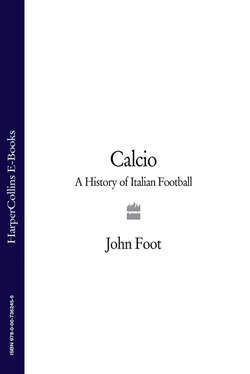Читать книгу Calcio: A History of Italian Football - John Foot - Страница 68
The Provinces. Bologna, Cagliari, Verona
ОглавлениеOnly three provincial teams have won championships since 1945. Bologna, under Fulvio Bernardini and with midfielder Giacomo Bulgarelli as their charismatic star, won a controversial playoff with Inter in 1964. Since then the club has been through ups and downs, including going bust and being sent down to Serie C in 1993. After that humiliating moment, the club worked its way back up to Serie A, where it settled into mid-table respectability, before slipping back to Serie B in 2005.
Cagliari’s period of glory was in the late 1960s and early 1970s, and was based around the unique talent of Gigi Riva, who led the whole island into days of wild celebration after the 1969–70 championship. Provincial Verona, finally, won an unexpected scudetto in 1985, with a team lacking in stars apart from the Danish striker Preban Elkaer. Most commentators attribute that victory to the subtle management skills of a coach born in the working-class Milanese neighbourhood of Bovisa, Osvaldo Bagnoli.
Since Sampdoria’s victory in 1991, it has been increasingly difficult for smaller teams to mount a serious challenge. Money talks in the age of pay-per-view and the Champions League, and just four clubs have shared the championship in the last fourteen years – Juventus (6), Milan (6), Roma (1) and Lazio (1). The massive financial difficulties of the Rome clubs by 2004 seemed to point to a three-horse race from here on in: Juvemilaninter. Inter were the odd team out in this equation, a big, rich club who kept failing to win anything at all.11 Nobody else could get a look in. The unpredictability of the championship, which occasionally threw up romantic stories of loyalty, team spirit and shock results, had been killed off by the corporate nature of the contemporary game. Two football analysts have argued that this trend is part of a general shift towards something they call ‘neo-football’. In contrast to the game that became popular in the 1930s and boomed again in the 1950s and 1960s, neo-football is above all a TV and business phenomenon. It is also detached from space and territory and increasingly globalized. The domination of the same big clubs – which are now brands marketed across the world, largely through internet and digital technology – guarantees a world-wide audience and also contributes to the decline of the national teams. In the neo-football world, only two or three teams are ever able to challenge for the championship, money talks and the rest are just bit-part players on a globalized world stage, where Milan players are household names in China and Japan and football is played 365 days a year.12
